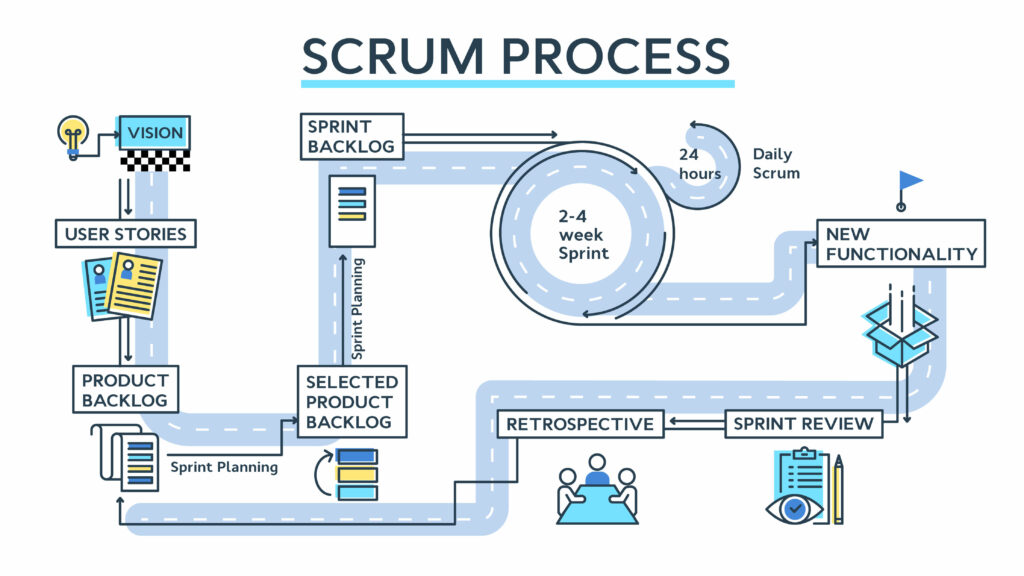In this article, we’re going to examine what Agile product management is and how Agile product management with scrum really works.
Now, there have been many advancements when it comes to technology. In the last 20 years alone, we’ve seen the rise and fall of many electronic devices, systems, platforms and so on.
If you think about the best email marketing services of today versus what existed only a few years ago, you’ll understand where I’m going with this.
Agile product management is, first and foremost, a methodology and a way of thinking.
So, from creating an Agile product management framework to mastering the process, what do you really have to take into account?
What is Agile Product Management?
Agile is a methodology, a framework that allows those using it to adapt and be more productive when it comes to creating and testing their product.
Using Agile methodology, a product is developed and tested simultaneously, as opposed to older project management methodologies, such as Waterfall or Critical Path Method (CPM).
Waterfall, for example, is a methodology still widely used today. At its very core, a Waterfall project consists of completing a project and then either building on its features, testing it or releasing it for public use.
This methodology requires extensive planning beforehand, as well as very careful planning while doing any alterations to the final product. Because it’s a very detailed project management methodology, it’s clear that one change can set the whole project back, compromising the quality of work of the teams and their delivery deadlines as well.
The Critical Path Method (CPM) works in a similar way, as it dictates that the tasks of a project need to be mapped out extensively beforehand and given a rough deadline. Through CPM, it is easy for the earliest and latest deadlines of the tasks to be calculated, which allows more accurate prioritization.
An Agile product management framework, on the other hand, is beneficial in the sense that it’s not looking to guess future desires and create products based on predictions. It actually works based on what the customer needs right now, and can easily adapt if that need changes. Hence the name Agile. Development is carried out based on constantly changing needs, rather than according to a plan that was made at the very start of the product.
However, there is no one framework and no one methodology, even for Agile product management. Agile is really the general term, under which more than one framework operates. Let’s now take a look at some of the different Agile methodologies and frameworks.
So, you can have:
- Scrum (which is what we’re going to talk about today)
- Feature Driven Development (FDD)
- Kanban
- Crystal
- Extreme Programming (XP)
- Dynamic Systems Development Method (DSDM)
And then some. But let’s move on with the definitions now, to understand how scrum can make Agile product management possible.
What is Scrum?
Scrum, as I mentioned earlier, is one of the many Agile project management methodologies. It is widely used, especially when it comes to managing a software development project.
The goal of Agile product management with scrum is to enable the product teams to release software or software updates once or twice each month.
Scrum falls under Agile’s wide umbrella, so we need to define it in relation to Agile product management as well. In those terms, the scrum model, or scrum project management, teaches teams to self-organize rather than religiously follow a very specific timeline that gets out of date very quickly as the project progresses.
Also, unlike more traditional project management methods, scrum is the one that encourages teams to learn as they go, rather than wait for the plan to either work or fail and then have to revisit their mistakes after missing the end goal. So, in a sense, through this methodology, teams also improve along with their product.
Basically, when you engage in Agile product management with scrum, your team will be required to do some things that may seem odd to those that practice traditional product management:
- You’ll first need to create a list of requirements that need to be completed, aka your product backlog. This way, you know what you need to do to build the product, one feature at a time.
- You will then work in what are called ‘sprints’. As you might be able to guess from the name, a sprint is a short and energetic period of work, lasting anywhere from a week to a month.
- For each sprint you will also create a list of tasks, selected from the product backlog. This is what the team will commit to delivering in a sprint, and is called the sprint backlog.
None of this needs to be thorough or detailed, but the features the team is going to work on need to be discussed. By the end of the sprint planning session, there will be a rough idea of how long each task is going to take and how they’re going to go about developing the product.
Each sprint allows the team to revisit the product and the original estimates and adjust according to what needs to be done next. So, you’ve got more frequent meetings, great team collaboration and the team decide themselves how they will build the product.
And this last bit is what improves focus, understanding of the product itself and understanding of the client’s own needs and expectations. Oh, and this is something that all teams should know and understand, in order to save on time, resources and manpower.

What is Agile Product Management with Scrum?
Agile product management with scrum is a methodology that I would characterize as “logical” or even “natural”, especially compared to the rest of the Agile product management methodologies.
You see, Agile is not a specific methodology in and of itself; it’s merely a set of values and principles around which a team’s daily tasks and activities revolve. And here’s where scrum comes to save the day, by providing specific artefacts and ceremonies (otherwise known as tools and meetings).
This logical, natural set of principles is what has made scrum so popular with more than just software development teams.
Who Can Use Agile Scrum Methodology?
The daily team meetings that occur when using Agile product management with scrum give team members clarity and focus when it comes to prioritizing. Therefore, it seems pretty beneficial for any team, whether they work on software development or not.
Some industries and teams that use the Agile scrum methodology are:
- The military: Good communication ensures great planning and great planning is essential when it comes to military operations.
- Marketing teams: Strategy and planning is essential when it comes to campaigns as well. And all marketers know that sometimes things might sound great in theory, but they just don’t work in practice. Daily meetings and sprints ensure that this won’t be a problem.
- Finance teams: If a company’s finances don’t need strategic planning and if finance teams don’t need to be up-to-date with everything, then I don’t know who does.
So, the only real answer to the question “Who can use Agile scrum methodology?” is that anyone and everyone can!

What Is Scrum in Relation to Agile Project Management?
I already mentioned that scrum is what gives the Agile product management framework the “push” it needs, in order to better operate and just make more sense.
Why Scrum? The Benefits
Now, let’s go into more detail about the benefits of Agile project management with scrum:
- Careful prioritization means that you will always deliver the highest value first.
- Delivering in intervals means it takes less time to push a new or an improved product to the market.
- Faster feedback loops, created by delivering in frequent intervals, leads to higher customer satisfaction.
- If your speed is higher, your productivity is higher too.
- There is a lot more clarity between team members, in regards to their own tasks, resulting in happier employees and better dynamics between the members.
- Teams that self-organize are teams that know how to remove a blocker without depending on anyone outside the team.
- More collaboration between team members means that they communicate well and solve problems quickly.
Now, unlike the more “old school” approaches, scrum requires a lot less preparation, research and planning. The goal is to have a rough estimate of what the product should actually do – this is known as the vision.
According to the “old school” approach, this makes zero sense, but it does in a fast-paced environment. There will be changes to the market and new requirements that no product manager is able to predict.
So, the guide under which the product is developed is not a guess or prediction but the customer or user’s feedback. Getting this feedback after every frequent release, as mentioned earlier, is one of the main benefits of scrum.
Those benefits don’t come for free, though.
The Requirements
Of course, every team needs to know what is required of them, right? Rather than giving the team extensive documentation, this can also be achieved via productive conversations. The backlog I mentioned earlier is created through those conversations. But this is not the only requirement the team needs to deliver on.
A non-functional requirement has nothing to do with functionality (hence the name non-functional) and everything to do with other parameters, like reliability or speed, for example.
If something doesn’t affect the product’s functionality but can affect a customer’s experience using it and eventually become a deal-breaker for them, it deserves as much place on the product backlog as a new feature request.
Requirements (both functional and non-functional) not only need to exist; they also need to be prioritized to deliver the maximum amount of value in the minimum amount of time. Scrum’s prioritization is based on value. That means that scrum teams work on the most important items first.
The Roles
Moving on to a very important section of Agile product management: The roles.
In traditional project management there are several roles, mainly performed by different people. So you have a product manager, a project manager, a product marketer and so on. But the more people who share the decision-making, the messier it gets, right?
Agile project management removes the need for lengthy discussions with various people and squeezes all these roles into one: The product owner. The product owner drives the vision of the product, and is the key decision-maker.
In more traditional project management, the “heads” of business units are detached from the development teams and working somewhat independently. In Agile product management, the product owner is an active member, working directly within the team.
If I had to define a product owner, I’d say the following: They are a happy medium between a businessman and a developer, able to understand customer needs and to communicate those to their team. And vice versa, able to explain to the customer what’s smart (and not smart) when it comes to technology.
The product owner works closely with the role known as the scrum master, who has an equally important role in Agile product management with scrum.
The scrum master facilitates the team on their journey to deliver the product. They help the team-work together and overcome problems that would otherwise hinder their progress.
Without the team itself, none of the above is useful or even possible, as this is the unit in which all technical tasks are being assessed and, eventually, completed. So, coding, analysis, testing, everything happens between the team members, making this unit the core of the Agile product management framework.
What Is Scrum Methodology Compared to Other Agile Approaches?
Scrum is not the only Agile methodology, as I mentioned in the beginning.
So, why scrum and not, let’s say, kanban, FDD or Crystal Clear?
Each approach has its own pros and cons, for sure. And scrum has some cons as well. But the basic pro is that its process is a natural and logical way to build and develop products over time.
Use scrum if you’re about to embark on a project that needs constant feedback from customers. Also, scrum methodology will allow you to figure things out as you go, seeing as you won’t need to know exactly how you want the product to look and feel. Just a general idea will do with scrum.
Scrum will also allow your team to deliver new features – in our case, software updates – to the market on a regular basis and work autonomously, despite the unknown variants.
That way, the team will be able to learn as it goes and grow in the same direction as the customers, rather than against them.
The Takeaway
Of course, there are also hybrid approaches and there is no one-size-fits-all type of methodology.
You’ll definitely find yourself alternating between Agile product management, kanban, and scrum, depending on the project and your knowledge.
Inspecting and adapting is of utmost importance and this is what will determine which method will get you the best results.
Frequently asked questions
What is Agile product management?
Agile project management is a process of creating products and services in an agile environment. Agile environment and frameworks facilitate iterative, customer-focused approach to product development, providing opportunities for companies to stay competitive, flexible, and customer-oriented throughout the whole product lifecycle from ideation to positioning and sales.
What is the role of a product manager in agile?
An agile product manager’s main responsibility is to perform all the necessary actions to keep the product development team focused on creating the best version of a product under specific requirements provided by company stakeholders, business agents, and customers.
What does Product Management mean?
Product management is a process of guiding, informing, and facilitating product development process, ensuring that the product development team works as effectively as possible and has all the necessary resources to consistently meet customer expectations and business requirements.
Frequently asked questions
What is Agile product management?
Agile project management is a process of creating products and services in an agile environment. Agile environment and frameworks facilitate iterative, customer-focused approach to product development, providing opportunities for companies to stay competitive, flexible, and customer-oriented throughout the whole product lifecycle from ideation to positioning and sales.
What is the role of a product manager in agile?
An agile product manager’s main responsibility is to perform all the necessary actions to keep the product development team focused on creating the best version of a product under specific requirements provided by company stakeholders, business agents, and customers.
What does Product Management mean?
Product management is a process of guiding, informing, and facilitating product development process, ensuring that the product development team works as effectively as possible and has all the necessary resources to consistently meet customer expectations and business requirements.



